Lots of Great Choices – But One Size Won’t Fit All
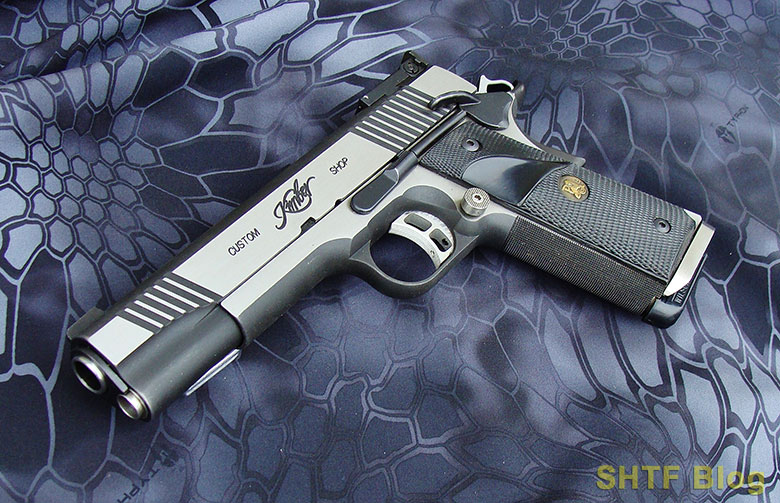
The U.S. Military is now into their second generation of standard-issue pistols since the Government Model 1911 was phased out. Replaced by the M-9 (Beretta M-92 FS) in 1985, the M17/18 (Sig P320) came next during 2017. Thus, except for those long in the tooth with military handgun experience, the 1911 is probably regarded more as an abstract relic by many veterans.
That may be true, but the Government Model is still a strong contender in the civilian market. Available in numerous calibers and sizes, many are true eye candy.
Polymer pistols enjoy strong sales, but the seemingly immortal Model 1911 Government Model still soldiers on. In fact, nowadays, old slab-sides has even been hybridized, one recent example being Springfield Armory’s high-capacity Prodigy. And like the majority of today’s single-stacks, this high-cap rendition incorporates features that were previously custom extras.
Prior to (and even well into) the debut of the Glock, many commercial Government Models started life pretty much as their military counterparts had. Three nearly obligatory upgrades were extended (beavertail) grip safeties, larger thumb safety pads, and a better set of sights – the latter the topic of this post.
1911 Sights – Many Options
Basic G.I. Sights
A genuine U.S. issued Government Model is a Spartan example of today’s possibilities. In fact, for those of us old enough to have carried one, the “forty-five” was already dated, the most recent issued specimens dating to World War II.
Lord knows mine had certainly seen its share of hard knocks, as evidenced by its appearance – and interesting history. Captured (actually recaptured) from an opponent no longer in need of its use, unlike some other battlefield pickups we frequently encountered, it was still configured as issued at some point during its murky past. I wish I’d recorded its markings, but priorities were different at the time.
After giving my “new” acquisition a thorough going over, it became my constant companion. Through some creative scrounging, I eventually accumulated a large stash of .45 “Hardball” rounds and magazines. The .45 is arguably one of several useful calibers to own, but one remaining loose end was the pistol’s bore, which showed heavily worn rifling. That problem was solved through dumb luck when, during a trip to the rear, I managed to score a new barrel. Today I’d obsess over its fitting and confirm the results via careful range testing.
Ignorance being bliss, I simply dropped in the replacement barrel and proceeded to ventilate an ammo can from around twenty paces. More luck: A satisfying seven-round group formed directly above the pistol’s sights and, from that point on, the old G.I. .45 performed admirably.
Back to the subject at hand, I never remotely considered its sights a hindrance. I attribute this to the following:
- At the time, my eyes were a whole lot younger. When I finally handed my trusty old Government Model off to a buddy, they, along with the rest of me, were only 21 years old.
- Related to the above, I’m a product of the era preceding computers, tablets and blue screens. During my pre-military days, phones had rotary dials and cords. Most households had televisions (initially black & white), but programming was limited to three networks received via rabbit ears or roof antennas. The expectation was, kids would either be in school or outdoors during daylight hours, with evenings reserved for homework. Result: My tender baby blues hadn’t been fried by steady exposure to electronics.
Earlier on, both of my parents were Word War II veterans who grew up without any visually based electronics other than incandescent lighting – still a novelty in many regions of the U.S. when they were kids. And the Model 1911 predates them both.
I’m betting the sights of my Grandfather’s Navy-issued World War I version were perfectly adequate for his non-light-polluted eyes. Lots of other old handguns from that period have seemingly rudimentary sights. True enough by today’s standards, but maybe their owners could actually see!
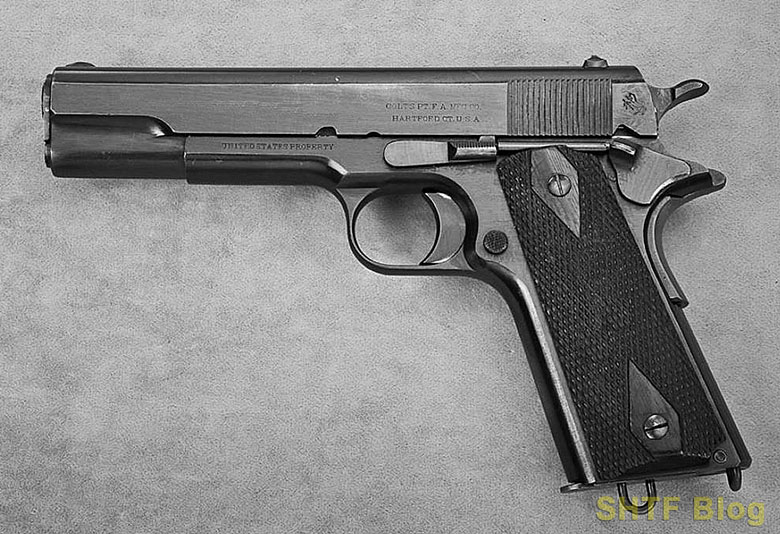
Anyhow, those days are long gone. And on a personal note, the issued sights of my old 1911 would be close to useless for my now aged eyes.
Good news: Due to the ongoing popularity of this pistol, there are lots of great aiming choices today – almost too many. The options include fixed or adjustable sights configured as three-dot versions, fiber optics, night sights, and even small battery-powered red dot units. Where to begin?
Red Dot Sights
Today, the aiming system for many shooters young and old is a miniaturized red dot sight (MRDS). These small electronic sights have advanced from novelty status to mainstream – to the point where many currently produced pistols are now offered with “optics ready” slides, or as fully decked-out packages. However, pickings are still lean among traditional 1911 offerings. And, as far as I’m concerned, that’s okay. Heck, even with an aluminum frame a standard-size 5-inch version is already quite a handful.
Previous size issues have been addressed through today’s genre of carry-friendly pistols, many of which are striker-fired compact 9mms. Thus, manufacturers of 1911s, aiming to please, now offer a number of competing smaller versions chambered for not only .45 ACP, but also 9mm. However, unlike the growing list of other compact pistols, optics-ready versions are conspicuously absent.
The reason probably boils down to reliable function. As originally designed, the Government Model was engineered to fire .45 Automatic Colt Pistol cartridges. The platform has since been adapted to fire a number of other calibers, but function-wise, the .45 ACP has always been the gold standard.
And, across the board, reliability becomes increasingly problematic commensurate with decreasing size, due to greater slide velocities and steeper unlocking angles. Fortunately, thanks to stiff demand and the ensuing R&D, most of these issues have now been overcome, and most of today’s smaller 1911s will run reliably – in their factory form.
But, when it comes to MRDS offerings, among Kimber’s extensive line, the only listed option is a Custom Shop 10mm version, (equipped with a Leupold Delta Point Pro). Likewise, Springfield Armory has a generous listing of 1911s, however, their MRDS platform is the high-cap Prodigy.
That said, the 1911 has been adapted to accommodate small optical systems. Beyond MRDS base adapters, existing slides can be machined (at considerable expense), or they can be purchased pre-machined from reputable sources such as Ed Brown: Ed brown 1911 Government Slide.
The great feature of Brown’s full-sized slide is, it’s machined for Trijicon’s 1911 RMR Mount, which ships with an integral night-sight and a dovetailed (NS green) front. The sights are tall enough to co-witness (lower 1/3) with Trijicon’s excellent RMR dot sights, providing the best of both worlds.
Playing it safe, a satisfactory installation will likely require the services of a competent gunsmith possessing the correct sight fixtures. Attempt to install a dovetailed night sight with a hammer and brass drift and you may discover its Tritium lamp is suddenly kaput. Also, there’s the associated expenses. Labor aside, the slide costs around $352, and the RMR mount is $211. Factor in more money for slide components.
Alternate solutions include small aftermarket bases designed to fit factory rear sight slots, something I’d just as soon skip – at least for defensive purposes.
Durable Iron Sight Options
Jumping back in time, if I could only add one upgrade to my battle-worn G.I. .45, it would have to be a foolproof set of “iron sights,” effective in all lighting conditions to include darkness. In fight-mode, durability would take top-billing over precise aiming.
Based on good results with two sight sets on a pair of small S&W polymer pistols (a 9mm Shield and .380 Bodyguard), I’d look hard at XD Sight’s “Big Dots” for a 1911. The front sight is humongous, but its “express” design nevertheless affords more precision than one might expect – and it’s also fast.
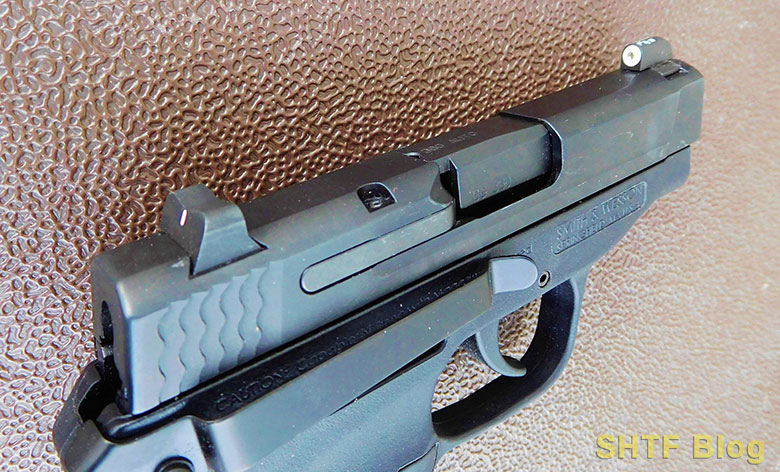
Another route, circling back to Kimber, their Rapide comes factory-equipped with a set of TRUGLO TFX Pro Day/Night Sights. As for the sights themselves, if you log on to TRUGLO’s site, you can peruse Truglo’s 1911 offerings. While you’re at it, note the slide cuts which are listed as “Novak LoMount” patterns.

Sights & Slides
The above is no more than a tiny sampler of the myriad sight possibilities. Nowadays, more 1911s are probably produced with slides machined to accept sights other than those of the original Colt/ Government Model.
Rear Sights
Today’s more common 1911 slide cuts correspond with the following sights:
Novak LoMount Introduced by Novak Designs in 1985, these streamlined low profile rear sights quickly caught on for defensive use, to the point where they became factory-issue for a number of pistol manufacturers. The line has since expanded to include versions for standard G.I. slides, as well as adjustable Novak models. See the variety of Novak sights.
As originally conceived by Novak, the sloping rear sight can sit low in a slide because it nests in a proprietary cut. But it wasn’t the first designed for use in an altered slide.
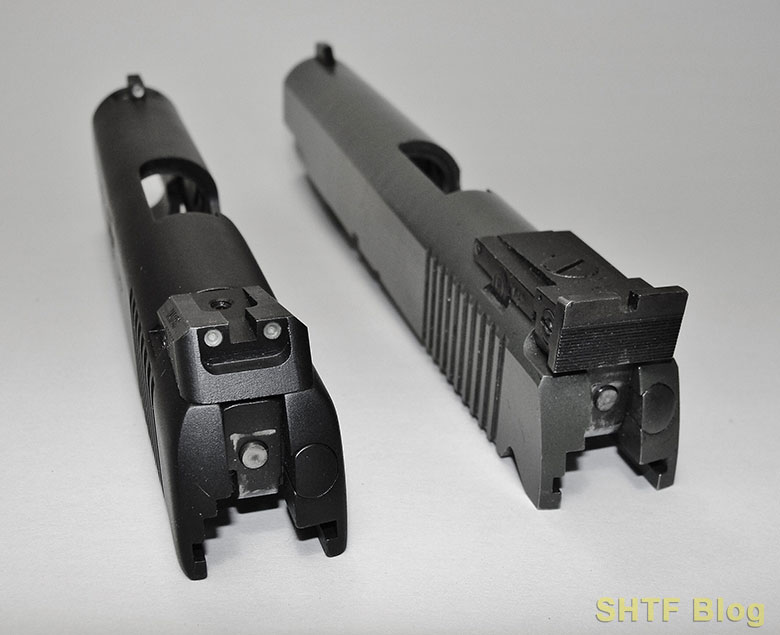
Elliason For many years the 1911 has been brought to a fine level of accuracy through careful fitting of its barrel, bushing, slide and frame, etc. Better sights were part of the package so, when Colt introduced a factory Gold Cup National Match version, it was sold with an adjustable rear sight. Recessed into its slide via a proprietary longitudinal slot, several iterations progressed to include a 1965 “Eliasson” design secured with a somewhat fragile cross-pin.
BoMar BMCS The emergence of the BoMar design provided a stronger low-mounted alternative to the Gold Cup’s sights. Although BoMar is no longer in business, fortunately for us, the design continues to thrive. It’s offered by several manufacturers, using a unique inset crosswise slide cut. Commonly seen atop serious competition 1911s, it’s also adaptable to defensive roles through the use of “melted” sight blades featuring Tritium inserts.
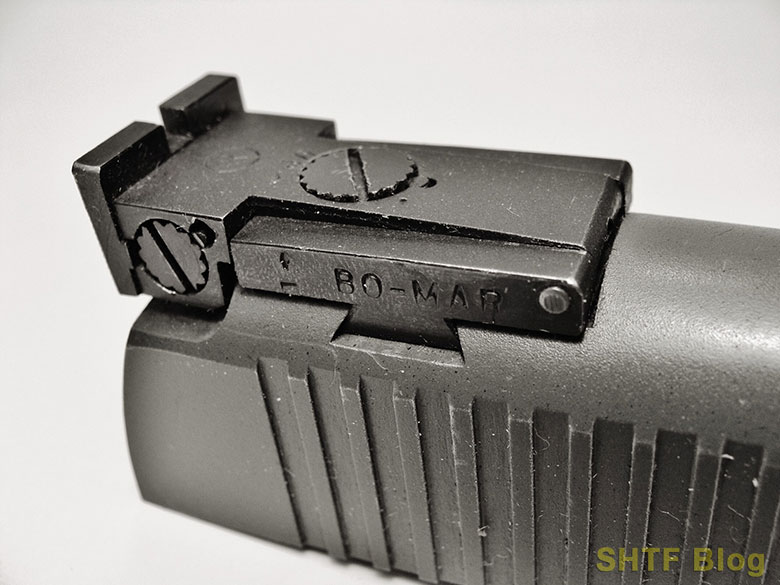
LPA TRT Similar to the BoMar pattern, the elevation screw is located differently, another proprietary design.
The takeaway: Particularly when upgrading to today’s great rear sight options, much like MRDS “footprints”, there is no universal size. But, thanks to the Internet, the necessary information is only a click away.
Front Sights
The 1911’s original front sight was “staked,” using a stem that protruded through the slide. Done right it’s secure enough (not all of ‘em are).
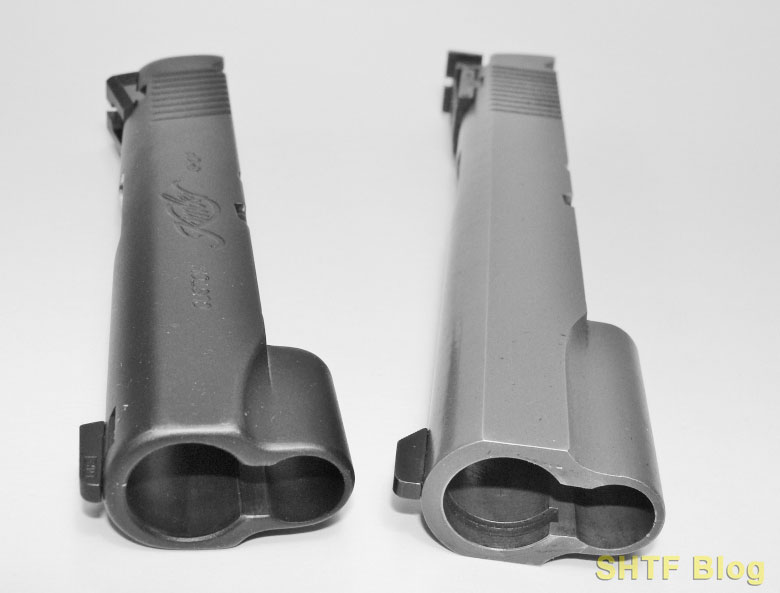
Replacements are available, but today, more slides feature horizontal dovetail cuts compatible with numerous useful designs. Beyond the various aiming options, different heights will usually correct elevation errors. However, because many are super-tight fits, as noted above, a properly designed fixture is the ticket to a damage-free installation. Also, since dovetail cuts can vary, matching combinations are required.
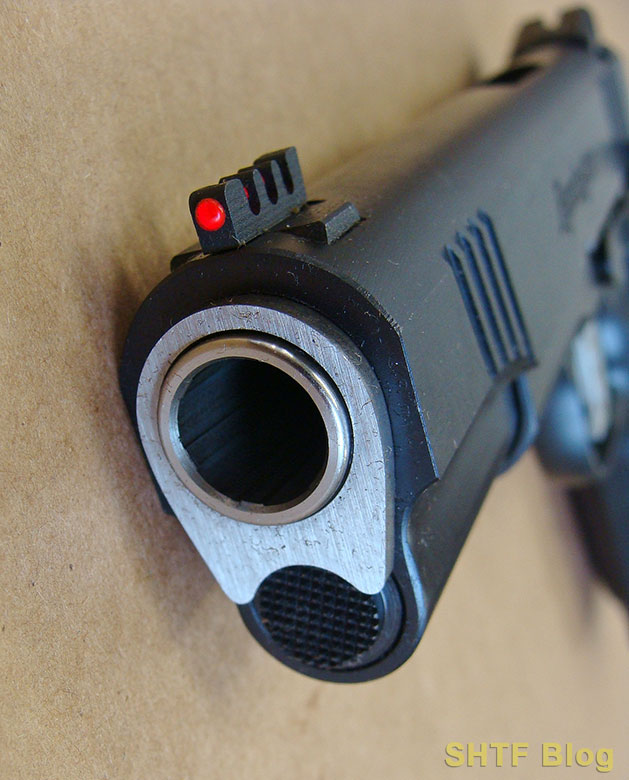
Lasers
Today, most lights and lasers are mounted to pistols via their integral accessory rails. The process is simple, but a new holster will probably be necessary. Say you already have an older pistol, possibly a 1911 of vintage stock. Assuming it runs reliably, one easy-to-install aiming upgrade is a laser.
As long as the pistol is built to spec, its grip panels can be exchanged a set of Crimson Trace Laser grips. It’s a simple kitchen table job requiring no more than a screwdriver. The laser can be zeroed off the iron sights without firing a shot (verify through some shooting), and a standard holster will probably work just fine.
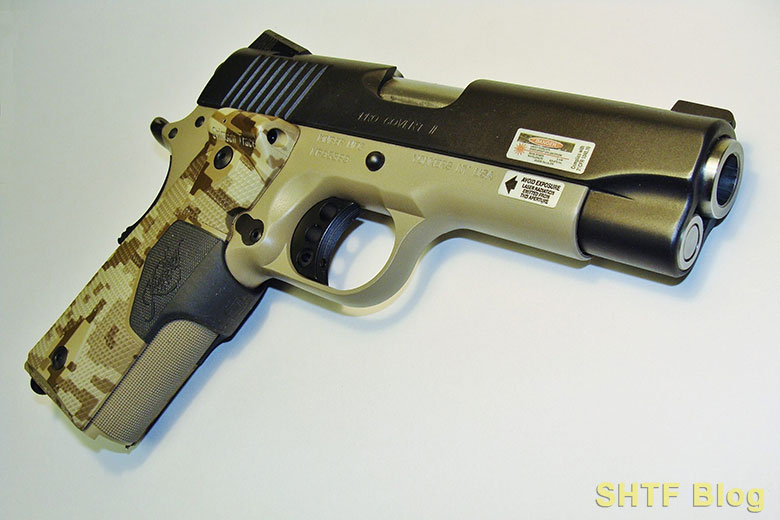
If a rail is preferred you can buy a 1911 so equipped, but the pistol will gain weight and need a different holster.
Parting Shots
For precise shooting, my hands-down favorite set of 1911 sights consist of a black BoMar adjustable rear (0.115” wide notch) paired with a narrow (0.110”), highly visible green fiber-optic front. But, with defense as a top priority, durability should lead, followed closely by fast acquisition in all lighting conditions. And if the rear sight incorporates a shelf permitting a single-handed slide rack, so much the better. Generally, these designs will be “fixed”, but some adjustable versions can be reasonable picks.

A Wilson KZ-9 on hand here is such an example: Like the STI (now Stacatto 2011), this 4-inch “1911” is an earlier hybrid high-cap design. I ordered it with Wilson’s BoMar-type Tritium “pyramid” rear (0.125” notch) and, because it’s a defensive pistol, its Tritium front sight is a bolder 0.125” – fast to pick up on the move. The night-sights of a 4” single-stack Kimber I owned produced high hits. That issue was resolved by replacing its Novak-type fixed rear with an adjustable Miniature Machine unit.
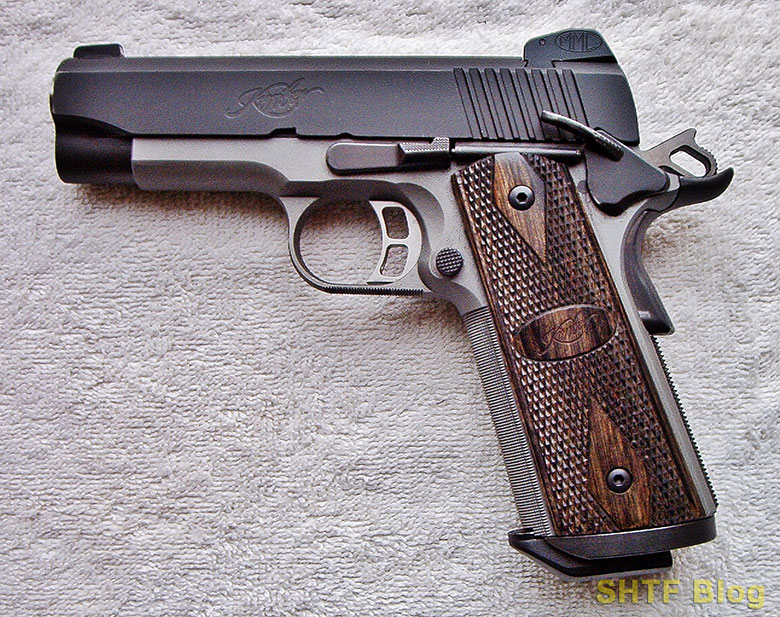
If starting from scratch, the simplest route is a 1911 already set up to meet personal needs. If it may serve more as a foundation for future upgrades, a factory-dovetailed front sight is worthwhile. Stick with mainstream domestic manufacturers and the dovetails will offer no surprises.
And believe me, I’m only scratching the surface! Google “1911 Sights” and fasten your seatbelt. Maybe, sit on your wallet, too! For more information about the 1911 and other handguns, here’s a link to Handguns: A Buyer’s and Shooter’s Guide.
- Markwith, Steve (Author)
- English (Publication Language)
- 418 Pages - 07/13/2019 (Publication Date) - Prepper Press (Publisher)

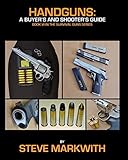
1 comment
Excellent !!! As a novice to the World of Firearms, I found your article very informative and well written because of it’s simplistic style of conveying the subject matter to the reader.
Well done my friend !